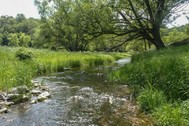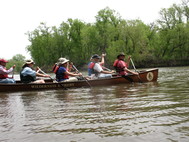
The Minnesota Pollution Control Agency (MPCA) is proposing to change its use designation rules for some Class 2 (aquatic life and recreation) and Class 7 (limited value) waters. The agency has published the proposed rule amendments in the Sept. 23 State Register. It will also hold a public information meeting about the proposed changes to Minnesota Rule 7050 on Oct. 29 (details below). The MPCA will accept comments on the proposed changes through 4:30 p.m. Nov. 7.
The overall purpose of the rule amendments is to update the use designations for 187 stream reaches and four lakes across Minnesota. See the draft list in the in the Amendments to Aquatic Life (Class 2) Use Designations document.
The “designated use” is a component of water quality standards that defines how the water is used. Class 2 waters are designated to protect aquatic life and recreation that include beneficial uses such as healthy fish communities and swimming. Class 7 waters or Limited Resource Value Waters are usually low-flow ditches and streams where the goals of fishable and swimmable are likely not achievable.
Under the federal Clean Water Act and Minnesota rules, the state assigns, or designates, beneficial uses, such as drinking water or recreation, to lakes and streams. Those designated uses then determine the physical and chemical criteria that the waters must meet to protect those beneficial uses. For example, if a lake is designated as Class 2 – aquatic life and recreation – then it must meet certain criteria to be fishable and swimmable.
The MPCA routinely reviews use designations to ensure that assigned beneficial uses are protective and attainable as defined by the Clean Water Act and Minnesota rules. The designated beneficial use for each water body must be correct and appropriate because the designated use affects many water quality protection and restoration efforts, such as:
- Assessment – determining whether lakes and streams meet water quality standards
- National Pollutant Discharge Elimination System (NPDES) permits for wastewater and stormwater discharges
- Watershed Restoration and Protection Strategies to bring impaired waters back to standards and protect waters in healthy conditions
The proposed rules focus on assigning appropriate use designations to individual waterbodies. They do not change numeric or narrative water quality standards. The proposed rules make updates and corrections to Class 2 and Class 7 beneficial use designations or classifications for streams and lakes. These updates fall into two groups:
- Reviewing streams and lakes for appropriate classification as cold or warm water habitats.
- Reviewing streams under the Tiered Aquatic Life Use (TALU) framework. The TALU rules are a framework for classifying streams based on the aquatic life each supports or has the potential to support, and builds upon existing water quality standards.
The MPCA will hold a public information meeting on the proposed changes on Oct. 29, from 3-5:30 p.m. at its St. Paul office, 520 Lafayette Road North, and by WebEx.
For more information, including how to access the Web Ex and how to submit comments, visit the Amendments to Water Quality Standards webpage.
|
Section 401 certification is a part of the federal Clean Water Act that allows states to have a role in ensuring that Minnesota projects that require permits from federal agencies, such as the U.S. Army Corps of Engineers, will meet the state’s water quality standards. Pipelines and mines are some of the projects affected by federal permitting and 401 certification. In some cases, Minnesota’s water quality standards are more stringent than federal standards, so it’s critical that that the MPCA have input on federal permitting that affects Minnesota waters.
The EPA is now proposing sweeping changes to 401 certification. “Some of the provisions that are proposed would significantly undermine the state’s ability to protect water quality within the state,” says Katrina Kessler, MPCA assistant commissioner.
For instance, the EPA is proposing that states issue Section 401 certification on a short timeline. For some projects, that might mean issuing the certification before all the science is in and before environmental review is completed. The states would be forced to makes decisions on projects without sufficient information on what impact the projects would have on the environment.
The MPCA is concerned that the proposed changes “really undermine the state’s ability to be in the driver’s seat and be the leader in terms of protecting local resources,” Kessler says.
For more information:
- Watch a video program on the MPCA website
- Visit the EPA website to see the proposed rule and to submit comments. The comment period ends Oct. 21.

The Legislative‐Citizen Commission on Minnesota Resources has tentatively selected 77 projects totaling $61.4 million to recommend to the 2020 Minnesota Legislature for funding from the Environment and Natural Resources Trust Fund. A final decision on recommendations is pending. The commission originally received 290 proposals requesting a total of about $203 million.
The commission makes funding recommendations to the Legislature for special environment and natural resource projects, primarily from the Environment and Natural Resources Trust Fund, derived from lottery proceeds and investment income. These projects help maintain and enhance Minnesota's environment and natural resources. For more information, visit the commission’s website.
|

Despite a reputation for murky water, the Minnesota River and its tributaries see plenty of recreational use. Those in the know enjoy paddling, fishing, and camping. Just ask Mark Bosacker, president of the Mankato Paddling and Outings Club (MPOC). Or the folks at Mankato-based Bent River Outfitter. Depending on water levels, the rivers in the Minnesota River Basin offer a range of paddling conditions, from gentle to series of rapids. Game fish abound in the favorite spots of local anglers. Or you can camp in a tipi at Upper Sioux Agency State Park.
Founded by Bob Zoet, MPOC organized in 1994 for river cleanup, group expeditions, and other outdoor activities. In the early years, they worked to clean up all kinds of trash dumped over the banks, mostly on popular sections of the Blue Earth and Le Sueur rivers. This year 40 attended a paddle on Swan Lake, and 10 on the Blue Earth River gorge.
Bent River Outfitter opened for business in 2011, specializing in kayak, canoe, stand up paddleboard, and snowshoe rental and guided trips in the surrounding river valleys. It recently held its second annual river clean-up event.
“I paddle mostly on all the smaller tributaries,” Bosacker said. “The Cobb, the Le Sueur, the Maple, the Watonwan, the Rush, and High Island Creek. At times the Blue Earth is crowded. On a hot summer day, the size of access parking lots is the limiting factor for the number of boaters on the Blue Earth.”
Today MPOC membership includes about 80 households. It owns four canoes, three kayaks, and an antique “war canoe” vintage 1925 that holds 10-12 people. They also have associations with Bent River Outfitter, Blue Earth River Rock Hoppers, and the Blue Earth Project, Bosacker said.
He joined the club at its second meeting in 1994. Its popularity grew quickly, drawing more than 300 people. “The initial motivation was to clean up trash,” he said. “Back then there was a lot of trash and tires, and there was competition to see who could collect the most.”
The National Guard pitched in, providing heavy equipment. One year, they recorded seven tons, and recovered the most tires in 2011. Blue Earth County also has been supportive.
“We were getting burned out, but it was a sport to see how much trash we could get in a canoe,” Bosacker said. “Now we are trying to pass effort on to younger people. The clean-up this past May did not find much garbage, and we were happy about that.”
The MPCA released new reports in July describing the need for widespread changes to help improve water quality in the Minnesota River Basin. The comment period for those reports closed on Sept. 20 and the MPCA is now working on its responses to those comments.
|

The Clean Water Council and legislators saw how the Legacy Amendment is making a difference to water quality in southeast Minnesota on a recent tour of the Rochester area.
Minnesota voters overwhelmingly approved the Legacy Amendment in 2008, which created a special tax that goes to the Clean Water Fund that helps implement projects and programs for water quality. In southeast Minnesota, the fund is helping restore streams, protect drinking water and develop new ag practices that help water quality.
Tour stops on Sept. 16 included:
- Restoration of Cascade Creek in Rochester
- Protection of Chatfield’s drinking water using a wellhead protection plan and the use of Kernza, a perennial grain with nitrogen-absorbing capabilities that is being tested around rural drinking water wells
- Viewing of karst and Big Spring near Fountain
- The Root River Field to Stream program, featuring a farm near Grand Meadow that evaluates how different agricultural practices affect runoff and the water quality of local rivers and streams
Learn more about the tour in the Rochester Post-Bulletin: SE Minnesota is flush with clean water projects.
|
|